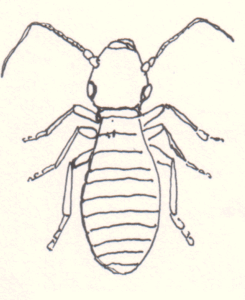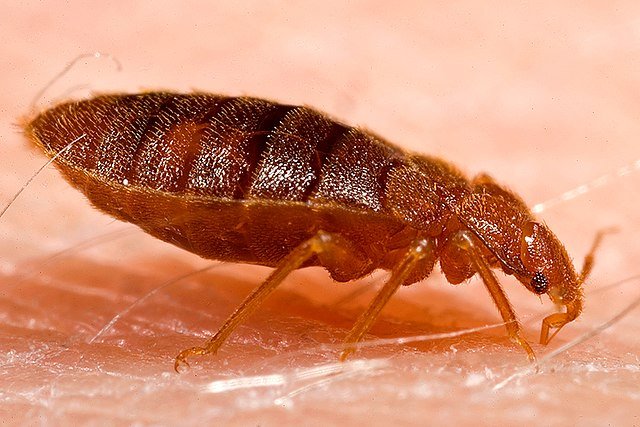Booklice in Bed: Identification, Risks, and Complete Control Guide
 Discovering tiny insects in your bed can be unsettling. While most people immediately think of bed bugs (Cimex lectularius), another offender may be to blame: booklice (order Psocoptera). These very small insects are not true lice. They don’t bite or feed on human blood. Instead, they thrive in humid indoor environments where mold, fungi, and starchy materials are present. Unfortunately, their presence in bedrooms and bedding is more common than many people realize, and most haven’t noticed or don’t know how to identify them. We usually discover them by chance when people call us for a bed bug treatment, or when the infestation becomes so severe that they realize something is in the house—but they don’t know what it is.
Discovering tiny insects in your bed can be unsettling. While most people immediately think of bed bugs (Cimex lectularius), another offender may be to blame: booklice (order Psocoptera). These very small insects are not true lice. They don’t bite or feed on human blood. Instead, they thrive in humid indoor environments where mold, fungi, and starchy materials are present. Unfortunately, their presence in bedrooms and bedding is more common than many people realize, and most haven’t noticed or don’t know how to identify them. We usually discover them by chance when people call us for a bed bug treatment, or when the infestation becomes so severe that they realize something is in the house—but they don’t know what it is.
This article provides a comprehensive guide on booklice in beds, covering how to identify them, their biology, global distribution, potential risks, infestation signs, and the most effective control methods.
In booklice cases, we first try to understand what caused the infestation. Was it always there? Did they come with a piece of furniture? Has humidity recently increased when it wasn’t an issue before? All these questions are evaluated by an experienced pest controller during the initial interview with the client.
Identification
Booklice are often mistaken for bed bugs, dust mites, or even head lice, but their characteristics set them apart:
Size: 1–2 mm in length, barely visible to the naked eye.
Color: Pale cream, gray, or light brown.
Shape: Soft-bodied with a large head, long antennae, and chewing mouthparts.
Wings: Most species indoors are wingless, unlike their outdoor relatives.
Movement: Quick crawlers, often seen near seams of books, mattresses, or window sills.
A key differentiator is that booklice are not parasites. Unlike fleas (Ctenocephalides felis) or lice (Pediculus humanus capitis), they do not bite humans or pets.
Biology and Ecology
Booklice belong to the order Psocoptera, which includes more than 5,000 species worldwide. Indoors, they thrive in environments with:
Relative humidity above 60%.
Mold and fungi growth (their main food source).
Starchy materials such as paper, glue, fabrics, and occasionally grains.
They reproduce rapidly under favorable conditions:
Females lay eggs individually or in clusters.
Nymphs molt 3–6 times before becoming adults.
The full life cycle can be completed in 1–2 months.
This adaptability makes them a recurring problem in humid homes.
Global Distribution
Booklice are found worldwide, but infestations indoors are common in:
Humid regions such as Southeast Asia, the Southern United States, and tropical climates.
Urban apartments with poor ventilation.
Old houses where mold accumulates behind wallpaper or within wooden furniture.
Stored food areas (pantries, grain storage, and kitchens).
Their presence in beds often comes from nearby sources of humidity and mold.
Risks and Damage
Booklice are nuisance pests rather than direct threats, but their impact is real:
Psychological discomfort: People confuse them with bed bugs and panic.
Allergic reactions: Some individuals report mild irritation or allergy-like symptoms from exposure.
Damage to property: Booklice feed on paper, book bindings, wallpaper paste, and fabrics, leading to long-term deterioration.
Food contamination: In pantries, they infest flour, cereals, and grains.
Though they do not transmit diseases like cockroaches (Blattella germanica) or mosquitoes (Aedes aegypti), their presence signals an underlying moisture problem that must be solved.
Signs of Infestation in Beds
Finding booklice in your bed may come as a surprise. Key signs include:
Tiny, fast-moving pale insects on sheets, pillowcases, or mattress seams.
Presence of mold or mildew near the bed frame, wall, or windows.
Damp spots in the room, especially in corners with poor ventilation.
Increased humidity levels above 60%.
Unlike bed bugs, booklice do not leave blood stains or bites. Their presence usually means the bed environment is damp enough to support mold.
Control Methods
1. Environmental Control
- We check all the furniture and the surrounding areas of the room—walls, floors, and other surfaces. We try to determine if anything has changed in the space. Perhaps a new piece of furniture was brought in, which now needs to be treated.
Reduce humidity: We Keep the relative humidity below 50% anyway. Use dehumidifiers and proper ventilation for that.
Increase temperature: Booklice thrive in cool, damp conditions; let's make their life difficult by raising indoor warmth, ot helps a lot.
Improve air circulation: Use fans or air conditioning to prevent moisture.
2. Cleaning and Sanitation
Wash bedding regularly in hot water (above 60°C).
Vacuum mattresses and furniture seams to remove insects and mold spores. The vacuum is your friend — and if you have a HEPA vacuum, even better.
Dispose of infested items such as old books, cardboard boxes, or damp fabrics—or treat them in a hot environment box if possible. They need to be exposed to temperatures above 60°C (140°F) for several minutes.
3. Chemical Control
In severe infestations:
Silica gel or diatomaceous earth can be applied to cracks and seams don't spread diatomaceous earth all around.
Residual insecticides (pyrethroids) may be used by licenced professionals.
4. Food and Storage Protection
Store grains, cereals, and flour in airtight containers, because booklice feed on starches and sugars.
Clean pantries and cupboards regularly.
Advanced Approaches
Professional pest control integrates multiple strategies:
Moisture mapping with specialized meters to detect hidden leaks.
HEPA vacuuming to remove mold spores.
Desiccant dusts applied in hidden voids.
Preventive sealing of cracks, wall voids, and storage areas.
This approach resembles integrated pest management (IPM) used for larger pests like roof rats (Rattus rattus) or termites (Reticulitermes flavipes), where prevention is key.
FAQ – Booklice in Bed
1. Do booklice bite humans?
No. Unlike bed bugs or fleas, booklice do not bite or feed on blood.
2. Why are booklice in my bed?
Their presence usually indicates high humidity and possible mold growth near your bed.
3. Can booklice cause health problems?
They do not spread diseases, but some people report mild allergies.
4. How do I permanently get rid of booklice in bed?
Lower humidity, eliminate mold, clean thoroughly, and use professional control if needed.
5. Are booklice and bed bugs the same?
No. Bed bugs (Cimex lectularius) are blood-feeding parasites, while booklice feed on fungi and starch.
6. Can I kill booklice with natural remedies?
Yes. Diatomaceous earth, baking soda, and silica gels can dry them out effectively.
7. Will they go away on their own?
If humidity drops below 50%, populations often collapse naturally.
Final Thoughts
Booklice (Psocoptera) in bed may not carry the same fear factor as bed bugs or cockroaches, but their presence can be stressful. They thrive in humid spaces, feeding on fungi, mold, and starchy materials rather than people or pets. The key to eliminating booklice is not just killing the insects but solving the moisture problem that sustains them. With proper humidity control, cleaning, and preventive measures, infestations can be resolved without long-term damage.
If you continue to find them in your bedroom despite DIY methods, it may be time to contact a certified pest control expert. Professionals can identify hidden moisture sources, apply safe treatments, and set up monitoring systems to ensure long-term relief.
Disclaimer
This article is for informational purposes only. Pest control laws and approved chemicals vary by country. For best results and legal safety, we strongly recommend contacting a licensed pest control professional in your local area. Always make sure that the pest control technician is properly certified or licensed, depending on your country’s regulations. It’s important to confirm that they only use approved products and apply them exactly as instructed on the product label. In most places in Europe, the UK, or the USA, following label directions is not just best practice—it’s the law.
Author Bio
Nasos Iliopoulos, BSc Agronomist & Certified Pest Control Expert
Scientific Director – Advance Services (Athens, Greece)
Licensed Pest Control Business – Ministry of Rural Development & Food (GR)
With expertise in entomology, pest management, and integrated solutions, Nasos Iliopoulos specializes in offering practical, science-based strategies for pest prevention and elimination.

